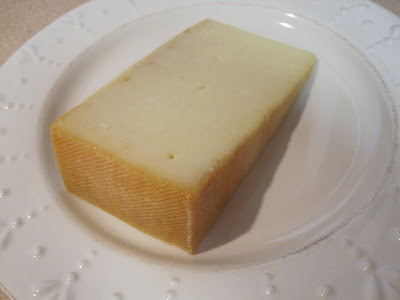Raclette cheese is made out of raw cow's milk. The milk is curdled, the curds are strained and packed into rounds and then aged.
The Raclette I got from Trader Joe's was made in the French Auvergne Mountains and aged over 60 days.
Raclette, however, appears to have originated in Switzerland and is often aged much longer, which would produce an even stronger cheese. It is semi-firm and often used for melting. It has a light brown rind and is light yellow with scattered holes in it.
It gets its name from the French word "racier" which means "to scrape." A dish, called Raclette, served in parts of Switzerland and France, includes Raclette cheese which has been warmed and then scraped onto a plate along with small potatoes in their skins, gherkins, pickled onions and dried meat, including ham and salamai. Traditionally, cow herders carried Raclette with them when they moved cows from the valley pastures into the mountains. They would place the cheese near the campfire at night and after it had melted sufficiently, put it on bread. Raclette has a little of a barnyard smell. In our taste-testing group, Sarah Frost said that it "smelled like dirty socks, but in a good way." I laughed when I found a post on Chowhound about Raclette with the comment, "it smells like feet with mild overtones of vomit...I this how it's supposed to be?" The taste grows and gets stronger and has a slight tang. Judy likened it to Munster cheese, crossed with moldy cheese.
Other comments from people in the group were "strong" and "very good." Another source said that when the Raclette is heated, it becomes special. The "full nutty, sweet and slightly fruity aroma intensifies and the elasticity of the melting cheese makes it truly magnificent." It has an ideal fat and moisture ratio that prevents the cheese from separating when it is melted. There was a little crunch in the rind. It has a nice smooth texture. There are lots of references on the web to Raclette parties and Raclette grills, grills used to cooked the cheese and parties where the melted cheese is place on boiled potatoes and vegetables. One reference said that Raclette could be used in the place of Emmentaler, but I find Raclette to be much more enjoyable and it does not have the "Swiss cheese" taste that I am not fond of. Another source said it was similar in texture and flavor to Gruyere. There again, I like Gruyere, but Raclette has a nicer texture and more flavor. Now that I have been reading about Raclette cheese and the Raclette dish and fondue, I am feeling a great urge to make the dish Raclette and use the melted cheese on potatoes, vegetables and some dried meats like prosciutto.
After the initial posting I discovered that Raclette du Valais is one of the 1001 Foods You Must Taste Before You Die. Raclette du Valais is made in Switzerland and is the most famous of the Raclette's. 1001 notes that in preparing the dish, Raclette, the cheese surface is put about two inches from the heat source. As a layer starts to melt it is scraped off downward onto a plate.
After the initial posting I discovered that Raclette du Valais is one of the 1001 Foods You Must Taste Before You Die. Raclette du Valais is made in Switzerland and is the most famous of the Raclette's. 1001 notes that in preparing the dish, Raclette, the cheese surface is put about two inches from the heat source. As a layer starts to melt it is scraped off downward onto a plate.




I suppose you'll be needing a raclette grill now. I remember in the Olympics of some years past a story on going to a Swiss/French/Italian/whatever Alpine town and ordering raclette. The heating device was suspended over the slab of cheese--quite a different looking grill than is what is out there now: the stone slab with little paddles sticking out from the sides. Now you've done the meat varieties, are you moving on to cheeses? I'll stay tuned. . .
ReplyDeleteYeah, I've become quite enchanted with cheese as of late. I had no previous appreciation for how much variety there is. There is a whole world of cheese out there I had no idea of. Part of the fun of trying new things. It is almost as fun as a trip to a new place, but cheaper.
ReplyDelete